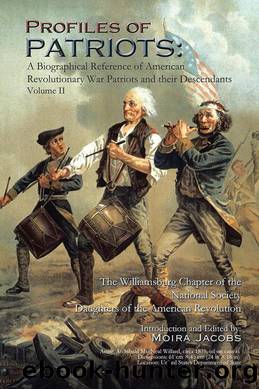Profiles of Patriots by Moira Ann Jacobs

Author:Moira Ann Jacobs [Jacobs, Moira Ann]
Language: eng
Format: epub
ISBN: 9781504979795
Publisher: AuthorHouse
Published: 2016-04-22T04:00:00+00:00
Jacob Rutsen DeWitt
By Jane M. Stewart
Patriot #: A032449
We were living in CT, celebrating a family Thanksgiving at my cousin Barbaraâs. During the evening my Aunt Jane, presented me with a folded and yellowed sheet of paper which she thought might interest me. I recognized the handwriting as that of my grandmother, Agnes Rose, and in her graceful script were many family names that I recognized: DeWitt Clinton, Governor of NY and responsible for the Erie Canal, Cousin George Clinton, Vice-President under Thomas Jefferson, and others. At the very bottom she noted Jacob Rutsen DeWitt, Captain â Revolutionary War. His name was all new and very exciting to me.
Computers at that time were dial-up, connected to the phone line, and very, very slow. We were subscribed to Prodigy, and I enjoyed the Bulletin Boards where I could download messages on categories of interest. I signed on to the Genealogy BB, and will never forget a message that read, âDoes anyone know anything about the persona of Jacob Rutsen DeWitt?â My heart jumped! I wrote back, âThantâs my 5th great grandfather!â I didnât realize then that I probably shared that ancestor with nearly a million others.
And so began my search for ancestors and my love of the DAR.
Jacob Rutsen DeWitt was born April 13, 1729 in Ulster County, NY, to Egbert DeWitt and Mary Nottingham. He married Janneke DePuy in 1756. About 1760, he built an old stone and frame house at the Neversink River and a grist mill near the aqueduct across the river. He also owned the farm he formerly occupied.
The Lenni Lenape Indians lived nearby, and were mostly peaceful in the early days of European settlement. On occasion there were disagreements which led to Indian attacks, especially during the French and Indian War (1754 â 1763). Forts with high picket fences around them were built for protection. There were three in the Upper Neighborhood (Ulster Co). Around 1770, Jacob built what was called âFort DeWitt,â on Prospect Hill Road, Cuddebackville, as his stockade home. It was garrisoned during the Revolutionary War and withstood Brantâs attack.
On July 21, 1779, Joseph Brant, a Mohawk chief, named Thayendanega, led 80 Indian and Tory raiders into the Lower Neighborhood by fording the Neversink River and then burning, looting and destroying homes, barns, mills and a school. Brant then headed north with cattle, horses and other supplies that had been looted. On July 22, about 120 militiamen from Orange and Ulster counties in NY and Sussex County in NJ gathered to plan an attack against Joseph Brant. The Brant raid on the Peenpack neighborhood on October 14, 1778 destroyed almost everything within present-day Cuddebackville, Godeffroy and Huguenot. The only habitable buildings left in the area were the homes of the DeWitts beside the Neversink River, the stone house of Ezekiel Gumaer, and Jacob Caudebecâs stone house. All had been fortified with stockade fences. The militia and local residents fought off Brant and his raiders.
During the winter of 1778-79, sixty-five settlers from the Peenpack neighborhood lived at Fort DeWitt because the rest of the homes had been burned.
Download
This site does not store any files on its server. We only index and link to content provided by other sites. Please contact the content providers to delete copyright contents if any and email us, we'll remove relevant links or contents immediately.
Machine Learning at Scale with H2O by Gregory Keys | David Whiting(4194)
Never by Ken Follett(3799)
Harry Potter and the Goblet Of Fire by J.K. Rowling(3776)
Unfinished: A Memoir by Priyanka Chopra Jonas(3333)
Fairy Tale by Stephen King(3222)
The Man Who Died Twice by Richard Osman(2998)
Will by Will Smith(2795)
Rationality by Steven Pinker(2291)
The Dark Hours by Michael Connelly(2246)
Can't Hurt Me: Master Your Mind and Defy the Odds - Clean Edition by David Goggins(2230)
It Starts With Us (It Ends with Us #2) by Colleen Hoover(2203)
The Storyteller by Dave Grohl(2174)
Friends, Lovers, and the Big Terrible Thing by Matthew Perry(2126)
The Dawn of Everything: A New History of Humanity by David Graeber & David Wengrow(2123)
The Becoming by Nora Roberts(2091)
The Stranger in the Lifeboat by Mitch Albom(2050)
Cloud Cuckoo Land by Anthony Doerr(2035)
Einstein: His Life and Universe by Walter Isaacson(1967)
Love on the Brain by Ali Hazelwood(1965)
